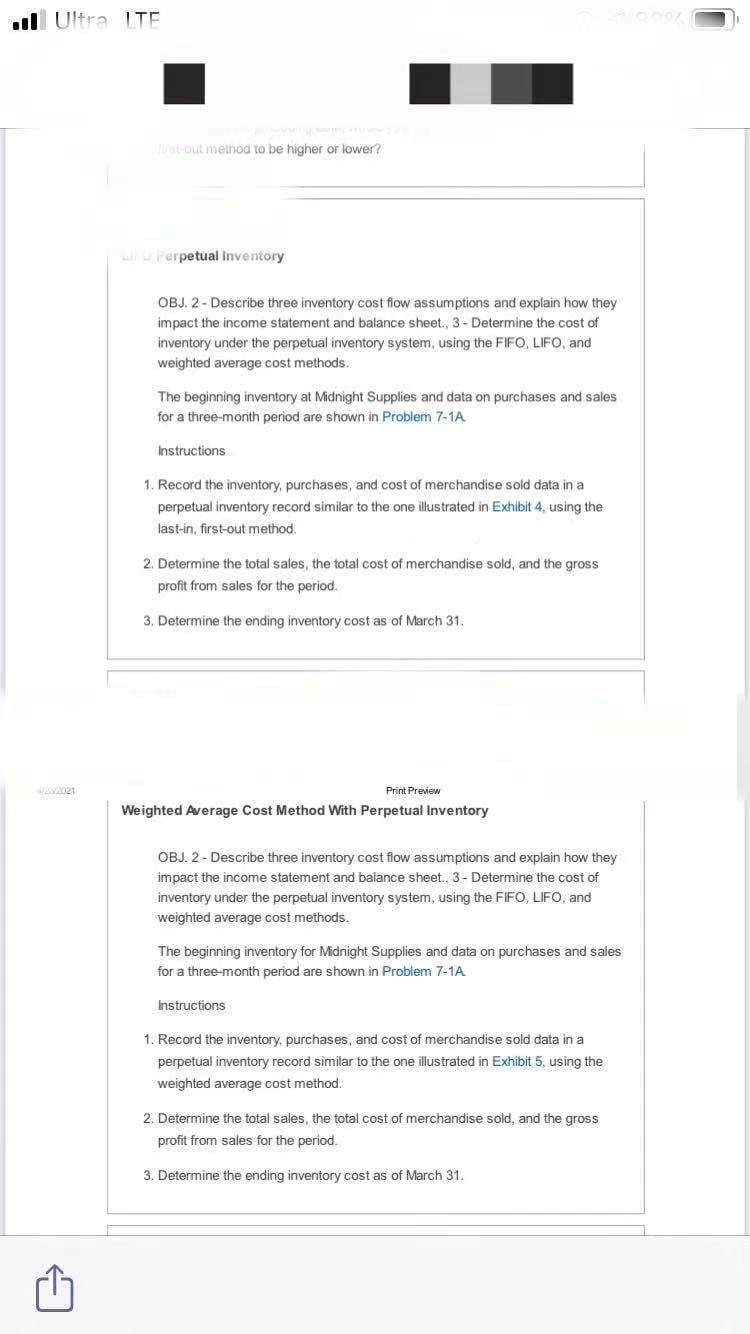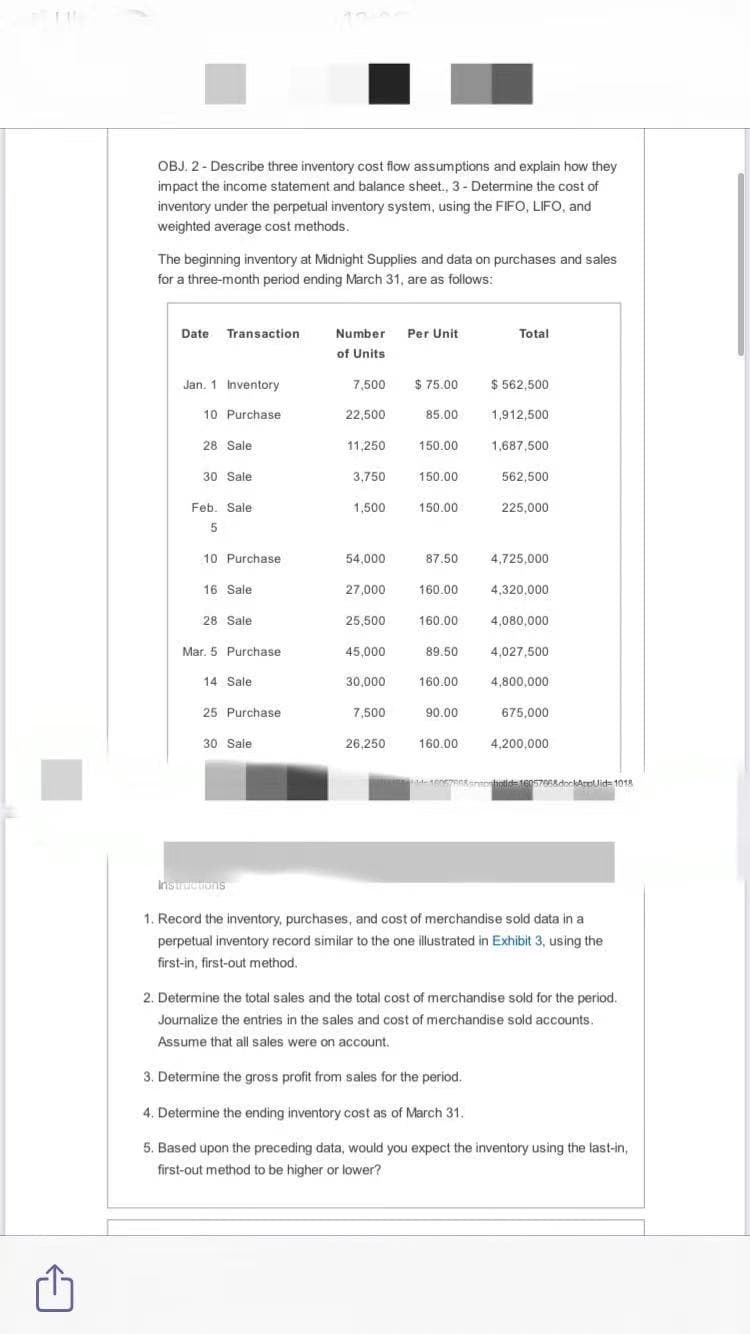OBJ. 2 - Describe three inventory cost flow assumptions and explain how they impact the income statement and balance sheet., 3- Determine the cost of inventory under the perpetual inventory system, using the FIFO, LIFO, and weighted average cost methods. The beginning inventory at Midnight Supplies and data on purchases and sales for a three-month period ending March 31, are as follows: Date Transaction Number Per Unit Total of Units Jan. 1 Inventory 7,500 $ 75.00 $ 562,500 10 Purchase 22,500 85.00 1,912,500 28 Sale 11,250 150.00 1,687,500 30 Sale 3,750 150.00 562,500 Feb. Sale 1,500 150.00 225,000 10 Purchase 54,000 87.50 4,725,000 16 Sale 27,000 160.00 4,320,000 28 Sale 25,500 160.00 4,080,000 Mar. 5 Purchase 45,000 89.50 4,027,500 14 Sale 30,000 160.00 4,800,000 25 Purchase 7,500 90.00 675,000 30 Sale 26,250 160.00 4,200,000 enntenanhotids160570dockAcolUid 101 Instructons 1. Record the inventory, purchases, and cost of merchandise sold data in a perpetual inventory record similar to the one illustrated in Exhibit 3, using the first-in, first-out method. 2. Determine the total sales and the total cost of merchandise sold for the period. Journalize the entries in the sales and cost of merchandise sold accounts. Assume that all sales were on account. 3. Determine the gross profit from sales for the period.
OBJ. 2 - Describe three inventory cost flow assumptions and explain how they impact the income statement and balance sheet., 3- Determine the cost of inventory under the perpetual inventory system, using the FIFO, LIFO, and weighted average cost methods. The beginning inventory at Midnight Supplies and data on purchases and sales for a three-month period ending March 31, are as follows: Date Transaction Number Per Unit Total of Units Jan. 1 Inventory 7,500 $ 75.00 $ 562,500 10 Purchase 22,500 85.00 1,912,500 28 Sale 11,250 150.00 1,687,500 30 Sale 3,750 150.00 562,500 Feb. Sale 1,500 150.00 225,000 10 Purchase 54,000 87.50 4,725,000 16 Sale 27,000 160.00 4,320,000 28 Sale 25,500 160.00 4,080,000 Mar. 5 Purchase 45,000 89.50 4,027,500 14 Sale 30,000 160.00 4,800,000 25 Purchase 7,500 90.00 675,000 30 Sale 26,250 160.00 4,200,000 enntenanhotids160570dockAcolUid 101 Instructons 1. Record the inventory, purchases, and cost of merchandise sold data in a perpetual inventory record similar to the one illustrated in Exhibit 3, using the first-in, first-out method. 2. Determine the total sales and the total cost of merchandise sold for the period. Journalize the entries in the sales and cost of merchandise sold accounts. Assume that all sales were on account. 3. Determine the gross profit from sales for the period.
Financial Accounting
15th Edition
ISBN:9781337272124
Author:Carl Warren, James M. Reeve, Jonathan Duchac
Publisher:Carl Warren, James M. Reeve, Jonathan Duchac
Chapter7: Inventories
Section: Chapter Questions
Problem 4PEB: Beginning inventory, purchases, and sales for WCS12 are as follows: Assuming a perpetual inventory...
Related questions
Question
Could you write down the answer?

Transcribed Image Text:l Ultra LTE
ol-out method to be higher or lower?
Ferpetual Inventory
OBJ. 2- Describe three inventory cost flow assumptions and explain how they
impact the income statement and balance sheet., 3- Determine the cost of
inventory under the perpetual inventory system, using the FIFO, LIFO, and
weighted average cost methods.
The beginning inventory at Midnight Supplies and data on purchases and sales
for a three-month period are shown in Problem 7-1A
Instructions
1. Record the inventory, purchases, and cost of merchandise sold data in a
perpetual inventory record similar to the one illustrated in Exhibit 4, using the
last-in, first-out method.
2. Determine the total sales, the total cost of merchandise sold, and the gross
profit from sales for the period.
3. Determine the ending inventory cost as of March 31.
Print Preview
Weighted Average Cost Method With Perpetual Inventory
OBJ. 2- Describe three inventory cost flow assumptions and explain how they
impact the income statement and balance sheet., 3- Determine the cost of
inventory under the perpetual inventory system, using the FIFO, LIFO, and
weighted average cost methods.
The beginning inventory for Midnight Supplies and data on purchases and sales
for a three-month period are shown in Problem 7-1A
Instructions
1. Record the inventory, purchases, and cost of merchandise sold data in a
perpetual inventory record similar to the one illustrated in Exhibit 5, using the
weighted average cost method.
2. Determine the total sales, the total cost of merchandise sold, and the gross
profit from sales for the period.
3. Determine the ending inventory cost as of March 31.

Transcribed Image Text:OBJ. 2- Describe three inventory cost flow assumptions and explain how they
impact the income statement and balance sheet., 3 - Determine the cost of
inventory under the perpetual inventory system, using the FIFO, LIFO, and
weighted average cost methods.
The beginning inventory at Midnight Supplies and data on purchases and sales
for a three-month period ending March 31, are as follows:
Date Transaction
Number Per Unit
Total
of Units
Jan. 1 Inventory
7,500
$ 75.00
$ 562,500
10 Purchase
22,500
85.00
1,912,500
28 Sale
11,250
150.00
1,687,500
30 Sale
3,750
150.00
562,500
Feb. Sale
1,500
150.00
225,000
5
10 Purchase
54,000
87.50
4,725,000
16 Sale
27,000
160.00
4.320.000
28 Sale
25,500
160.00
4,080,000
Mar. 5 Purchase
45,000
89.50
4,027,500
14 Sale
30,000
160.00
4,800,000
25 Purchase
7,500
90.00
675,000
30 Sale
26.250
160.00
4,200,000
hotids16057RRedockApplid= 1018
Instructons
1. Record the inventory, purchases, and cost of merchandise sold data in a
perpetual inventory record similar to the one illustrated in Exhibit 3, using the
first-in, first-out method.
2. Determine the total sales and the total cost of merchandise sold for the period.
Journalize the entries in the sales and cost of merchandise sold accounts.
Assume that all sales were on account.
3. Determine the gross profit from sales for the period.
4. Determine the ending inventory cost as of March 31.
5. Based upon the preceding data, would you expect the inventory using the last-in,
first-out method to be higher or lower?
Expert Solution
This question has been solved!
Explore an expertly crafted, step-by-step solution for a thorough understanding of key concepts.
This is a popular solution!
Trending now
This is a popular solution!
Step by step
Solved in 4 steps with 5 images

Knowledge Booster
Learn more about
Need a deep-dive on the concept behind this application? Look no further. Learn more about this topic, accounting and related others by exploring similar questions and additional content below.Recommended textbooks for you

Financial Accounting
Accounting
ISBN:
9781337272124
Author:
Carl Warren, James M. Reeve, Jonathan Duchac
Publisher:
Cengage Learning

Financial Accounting
Accounting
ISBN:
9781305088436
Author:
Carl Warren, Jim Reeve, Jonathan Duchac
Publisher:
Cengage Learning

Financial And Managerial Accounting
Accounting
ISBN:
9781337902663
Author:
WARREN, Carl S.
Publisher:
Cengage Learning,

Financial Accounting
Accounting
ISBN:
9781337272124
Author:
Carl Warren, James M. Reeve, Jonathan Duchac
Publisher:
Cengage Learning

Financial Accounting
Accounting
ISBN:
9781305088436
Author:
Carl Warren, Jim Reeve, Jonathan Duchac
Publisher:
Cengage Learning

Financial And Managerial Accounting
Accounting
ISBN:
9781337902663
Author:
WARREN, Carl S.
Publisher:
Cengage Learning,

Intermediate Accounting: Reporting And Analysis
Accounting
ISBN:
9781337788281
Author:
James M. Wahlen, Jefferson P. Jones, Donald Pagach
Publisher:
Cengage Learning

College Accounting, Chapters 1-27
Accounting
ISBN:
9781337794756
Author:
HEINTZ, James A.
Publisher:
Cengage Learning,

Principles of Accounting Volume 1
Accounting
ISBN:
9781947172685
Author:
OpenStax
Publisher:
OpenStax College